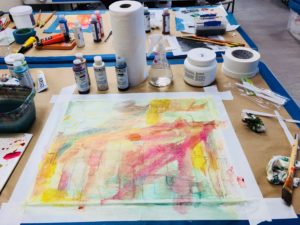I stood at the work table in the Taos art studio and looked down at my canvas. I had just completed sketching a design onto my canvas with a pencil, and even though it looked nothing like the sketch on my paper, I was pleased that I had some kind of structure in place before I began painting.


I put three colors of paint down on my palette, dipped my brush in some water and made a very thin puddle of a golden, transparent acrylic. I tried to imitate how I had seen Gwen Fox approach her canvas–with loose arms and shoulders and complete confidence.
Gwen had instructed us earlier that morning that we should paint thin and quickly, especially on the first few layers. This technique would help give our work the luminous quality we all sought.
I went for it.

Once the first couple of layers were down on my canvas, though, I could no longer see the sketched design beneath the paint. I had something of a panic attack. As the end of the day was nearing, I decided to gesso over my entire canvas, re-sketch my design, and start painting again the next morning.
After some sleep and a fresh start with a clean slate, I felt better. I sketched my design again and started layering paint. I noticed immediately how much I was in my head and how stiff I was painting. The free spirited feeling I had had the day before was now replaced with a frustrated, furrowed-brow demeanor.
And, of course, my work reflected that.

I had lost the energy of the brush strokes from the first day. I was painting from my head and not my heart. I soldiered on.
While we did have lectures, demonstrations, and a few other exercises during the week, I spent the majority of each day working away on that one canvas. It had become a wrestling match. A fight to the death.
The painting traversed multiple iterations, layer upon layer upon layer.



I felt as if I were painting the floor and had backed myself into a corner with no way out. The more I painted, the worse the painting became. The more I chased creating a design with energy, light, and flow, the more it ran in the opposite direction.
I painted and painted and painted. It had become a battle of will, and I was not relenting. Through the briars and darkness, I pushed forward.
And when I realized I could not continue on in the same energetic state, something amazing happened: I gave up. I stopped fighting against myself and the canvas. I exhaled deeply and surrendered to the painting.
“What do you want to become?” I asked the painting softly.
I kept working, but now my posture was open, soft. I released my rule-based intentions and began to play with the paint. After an hour or so, something started to emerge from the canvas. Colors suggested themselves to me. Light, interest, and fun had joined the party. By the end of the day, I had my finished work.

I nearly cried with joy and pride as I stood in front of my classmates during the critique session. The first completed painting of my entire life was propped up on an easel while everyone viewed and commented. One comment from my table mate flew across the room and into my heart: “I watched you all week, Susie. You never gave up. You worked, and worked, and worked.”
I took in her words as they resonated within me. It was true–I had worked my ass off. Working with diligence had always been my signature special sauce. I just always refuse to give up.
But in that moment, I knew something profound had happened to me. It was by giving in–surrendering–that I had touched the corner of a divine shroud of creativity.
The very birthplace of inspired imagination, joy, and courage.










